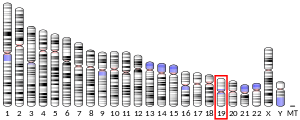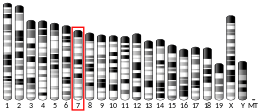CD37
Leukocyte antigen CD37 is a protein that in humans is encoded by the CD37 gene.[5][6]
| CD37 | |||||||||||||||||||||||||
|---|---|---|---|---|---|---|---|---|---|---|---|---|---|---|---|---|---|---|---|---|---|---|---|---|---|
| Identifiers | |||||||||||||||||||||||||
| Aliases | CD37, GP52-40, TSPAN26, CD37 molecule | ||||||||||||||||||||||||
| External IDs | OMIM: 151523 MGI: 88330 HomoloGene: 20422 GeneCards: CD37 | ||||||||||||||||||||||||
| |||||||||||||||||||||||||
| |||||||||||||||||||||||||
| |||||||||||||||||||||||||
| |||||||||||||||||||||||||
| Orthologs | |||||||||||||||||||||||||
| Species | Human | Mouse | |||||||||||||||||||||||
| Entrez | |||||||||||||||||||||||||
| Ensembl | |||||||||||||||||||||||||
| UniProt | |||||||||||||||||||||||||
| RefSeq (mRNA) | |||||||||||||||||||||||||
| RefSeq (protein) | |||||||||||||||||||||||||
| Location (UCSC) | Chr 19: 49.34 – 49.34 Mb | Chr 7: 45.23 – 45.24 Mb | |||||||||||||||||||||||
| PubMed search | [3] | [4] | |||||||||||||||||||||||
| Wikidata | |||||||||||||||||||||||||
| |||||||||||||||||||||||||
Function
The protein encoded by this gene is a member of the transmembrane 4 superfamily, also known as the tetraspanin family. Most of these members are cell-surface proteins that are characterized by the presence of four hydrophobic transmembrane domains. Tetraspanins mediate signal transduction events that play a role in the regulation of immune responses, cell development, activation, growth and motility.[7][8][9][10] CD37 expression is restricted to cells of the immune system, with highest abundance on mature B cells, and lower expression is found on T cells and myeloid cells. CD37 is a cell surface glycoprotein that is known to complex with integrins and other transmembrane 4 superfamily proteins. Alternate splicing results in multiple transcript variants encoding different isoforms.[6] CD37 controls both humoral[11][12] and cellular immune responses.[13][14][15] CD37-deficiency in mice leads to spontaneous development on B cell lymphoma,[16] and patients with CD37-negative lymphomas have a worse clinical outcome.[17]
See also
References
- GRCh38: Ensembl release 89: ENSG00000104894 - Ensembl, May 2017
- GRCm38: Ensembl release 89: ENSMUSG00000030798 - Ensembl, May 2017
- "Human PubMed Reference:". National Center for Biotechnology Information, U.S. National Library of Medicine.
- "Mouse PubMed Reference:". National Center for Biotechnology Information, U.S. National Library of Medicine.
- Virtaneva KI, Angelisová P, Baumruker T, Horejsí V, Nevanlinna H, Schröder J (Mar 1993). "The genes for CD37, CD53, and R2, all members of a novel gene family, are located on different chromosomes". Immunogenetics. 37 (6): 461–5. doi:10.1007/BF00222471. hdl:10138/157839. PMID 8436422.
- "Entrez Gene: CD37 CD37 molecule".
- Levy S, Shoham T (February 2005). "The tetraspanin web modulates immune-signalling complexes". Nature Reviews. Immunology. 5 (2): 136–48. doi:10.1038/nri1548. PMID 15688041.
- Charrin S, le Naour F, Silvie O, Milhiet PE, Boucheix C, Rubinstein E (May 2009). "Lateral organization of membrane proteins: tetraspanins spin their web". The Biochemical Journal. 420 (2): 133–54. doi:10.1042/BJ20082422. PMID 19426143.
- Hemler ME (October 2005). "Tetraspanin functions and associated microdomains". Nature Reviews Molecular Cell Biology. 6 (10): 801–11. doi:10.1038/nrm1736. PMID 16314869.
- van Deventer SJ, Dunlock VE, van Spriel AB (2017-06-15). "Molecular interactions shaping the tetraspanin web". Biochemical Society Transactions. 45 (3): 741–750. doi:10.1042/BST20160284. PMID 28620035.
- van Spriel AB, Sofi M, Gartlan KH, van der Schaaf A, Verschueren I, Torensma R, Raymakers RA, Loveland BE, Netea MG, Adema GJ, Wright MD, Figdor CG (March 2009). "The tetraspanin protein CD37 regulates IgA responses and anti-fungal immunity". PLoS Pathogens. 5 (3): e1000338. doi:10.1371/journal.ppat.1000338. PMC 2650281. PMID 19282981.
- van Spriel AB, de Keijzer S, van der Schaaf A, Gartlan KH, Sofi M, Light A, Linssen PC, Boezeman JB, Zuidscherwoude M, Reinieren-Beeren I, Cambi A, Mackay F, Tarlinton DM, Figdor CG, Wright MD (November 2012). "The tetraspanin CD37 orchestrates the α(4)β(1) integrin-Akt signaling axis and supports long-lived plasma cell survival". Science Signaling. 5 (250): ra82. doi:10.1126/scisignal.2003113. PMID 23150881.
- Knobeloch KP, Wright MD, Ochsenbein AF, Liesenfeld O, Löhler J, Zinkernagel RM, Horak I, Orinska Z (August 2000). "Targeted inactivation of the tetraspanin CD37 impairs T-cell-dependent B-cell response under suboptimal costimulatory conditions". Molecular and Cellular Biology. 20 (15): 5363–9. doi:10.1128/MCB.20.15.5363-5369.2000. PMC 85988. PMID 10891477.
- van Spriel AB, Puls KL, Sofi M, Pouniotis D, Hochrein H, Orinska Z, Knobeloch KP, Plebanski M, Wright MD (March 2004). "A regulatory role for CD37 in T cell proliferation". Journal of Immunology. 172 (5): 2953–61. doi:10.4049/jimmunol.172.5.2953. PMID 14978098.
- Sheng KC, van Spriel AB, Gartlan KH, Sofi M, Apostolopoulos V, Ashman L, Wright MD (January 2009). "Tetraspanins CD37 and CD151 differentially regulate Ag presentation and T-cell co-stimulation by DC". European Journal of Immunology. 39 (1): 50–5. doi:10.1002/eji.200838798. PMID 19089816.
- de Winde CM, Veenbergen S, Young KH, Xu-Monette ZY, Wang XX, Xia Y, Jabbar KJ, van den Brand M, van der Schaaf A, Elfrink S, van Houdt IS, Gijbels MJ, van de Loo FA, Bennink MB, Hebeda KM, Groenen PJ, van Krieken JH, Figdor CG, van Spriel AB (February 2016). "Tetraspanin CD37 protects against the development of B cell lymphoma". The Journal of Clinical Investigation. 126 (2): 653–66. doi:10.1172/JCI81041. PMC 4731177. PMID 26784544.
- Xu-Monette ZY, Li L, Byrd JC, Jabbar KJ, Manyam GC, Maria de Winde C, van den Brand M, Tzankov A, Visco C, Wang J, Dybkaer K, Chiu A, Orazi A, Zu Y, Bhagat G, Richards KL, Hsi ED, Choi WW, Huh J, Ponzoni M, Ferreri AJ, Møller MB, Parsons BM, Winter JN, Wang M, Hagemeister FB, Piris MA, Han van Krieken J, Medeiros LJ, Li Y, van Spriel AB, Young KH (December 2016). "Assessment of CD37 B-cell antigen and cell of origin significantly improves risk prediction in diffuse large B-cell lymphoma". Blood. 128 (26): 3083–3100. doi:10.1182/blood-2016-05-715094. PMC 5201094. PMID 27760757.
Further reading
- Horejsí V, Vlcek C (August 1991). "Novel structurally distinct family of leucocyte surface glycoproteins including CD9, CD37, CD53 and CD63". FEBS Letters. 288 (1–2): 1–4. doi:10.1016/0014-5793(91)80988-F. PMID 1879540.
- Berditchevski F (December 2001). "Complexes of tetraspanins with integrins: more than meets the eye". Journal of Cell Science. 114 (Pt 23): 4143–51. PMID 11739647.
- Classon BJ, Williams AF, Willis AC, Seed B, Stamenkovic I (September 1990). "The primary structure of the human leukocyte antigen CD37, a species homologue of the rat MRC OX-44 antigen". The Journal of Experimental Medicine. 172 (3): 1007. doi:10.1084/jem.172.3.1007. PMC 2188538. PMID 2388030.
- Classon BJ, Williams AF, Willis AC, Seed B, Stamenkovic I (April 1989). "The primary structure of the human leukocyte antigen CD37, a species homologue of the rat MRC OX-44 antigen". The Journal of Experimental Medicine. 169 (4): 1497–502. doi:10.1084/jem.169.4.1497. PMC 2189247. PMID 2466944.
- Schwartz-Albiez R, Dörken B, Hofmann W, Moldenhauer G (February 1988). "The B cell-associated CD37 antigen (gp40-52). Structure and subcellular expression of an extensively glycosylated glycoprotein". Journal of Immunology. 140 (3): 905–14. PMID 3257508.
- Angelisová P, Hilgert I, Horejsí V (1994). "Association of four antigens of the tetraspans family (CD37, CD53, TAPA-1, and R2/C33) with MHC class II glycoproteins". Immunogenetics. 39 (4): 249–56. doi:10.1007/BF00188787. PMID 8119731.
- Wright MD, Rochelle JM, Tomlinson MG, Seldin MF, Williams AF (February 1993). "Gene structure, chromosomal localization, and protein sequence of mouse CD53 (Cd53): evidence that the transmembrane 4 superfamily arose by gene duplication". International Immunology. 5 (2): 209–16. doi:10.1093/intimm/5.2.209. PMID 8452817.
- Serru V, Le Naour F, Billard M, Azorsa DO, Lanza F, Boucheix C, Rubinstein E (May 1999). "Selective tetraspan-integrin complexes (CD81/alpha4beta1, CD151/alpha3beta1, CD151/alpha6beta1) under conditions disrupting tetraspan interactions". The Biochemical Journal. 340 (1): 103–11. doi:10.1042/0264-6021:3400103. PMC 1220227. PMID 10229664.
- Okochi H, Mine T, Nashiro K, Suzuki J, Fujita T, Furue M (July 1999). "Expression of tetraspans transmembrane family in the epithelium of the gastrointestinal tract". Journal of Clinical Gastroenterology. 29 (1): 63–7. doi:10.1097/00004836-199907000-00016. PMID 10405235.
- Matsumoto K, Bochner BS, Wakiguchi H, Kurashige T (1999). "Functional expression of transmembrane 4 superfamily molecules on human eosinophils". International Archives of Allergy and Immunology. 120 Suppl 1: 38–44. doi:10.1159/000053592. PMID 10529602.
- van Spriel AB, Puls KL, Sofi M, Pouniotis D, Hochrein H, Orinska Z, Knobeloch KP, Plebanski M, Wright MD (March 2004). "A regulatory role for CD37 in T cell proliferation". Journal of Immunology. 172 (5): 2953–61. doi:10.4049/jimmunol.172.5.2953. PMID 14978098.
- Suzuki Y, Yamashita R, Shirota M, Sakakibara Y, Chiba J, Mizushima-Sugano J, Nakai K, Sugano S (September 2004). "Sequence comparison of human and mouse genes reveals a homologous block structure in the promoter regions". Genome Research. 14 (9): 1711–8. doi:10.1101/gr.2435604. PMC 515316. PMID 15342556.
- Meyer-Wentrup F, Figdor CG, Ansems M, Brossart P, Wright MD, Adema GJ, van Spriel AB (January 2007). "Dectin-1 interaction with tetraspanin CD37 inhibits IL-6 production". Journal of Immunology. 178 (1): 154–62. doi:10.4049/jimmunol.178.1.154. PMID 17182550.
- Zhao X, Lapalombella R, Joshi T, Cheney C, Gowda A, Hayden-Ledbetter MS, Baum PR, Lin TS, Jarjoura D, Lehman A, Kussewitt D, Lee RJ, Caligiuri MA, Tridandapani S, Muthusamy N, Byrd JC (October 2007). "Targeting CD37-positive lymphoid malignancies with a novel engineered small modular immunopharmaceutical". Blood. 110 (7): 2569–77. doi:10.1182/blood-2006-12-062927. PMC 1988922. PMID 17440052.
External links
- CD37+protein,+human at the US National Library of Medicine Medical Subject Headings (MeSH)
- Human CD37 genome location and CD37 gene details page in the UCSC Genome Browser.
This article incorporates text from the United States National Library of Medicine, which is in the public domain.




